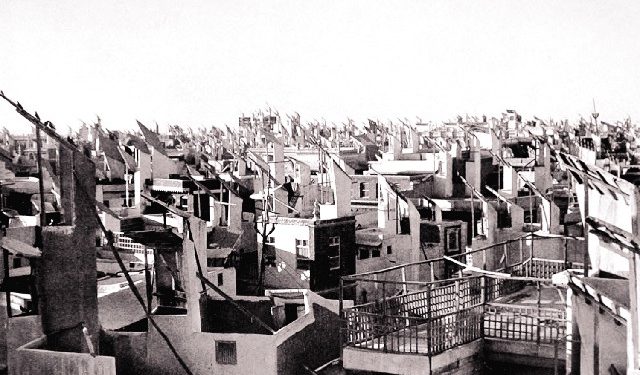
The architectural historians had different opinions about the origin of wind catchers. Some of them thought that wind catchers originated in Egypt, and others argued that this technique was developed in Iran.
Dr. Zaffar Junejo
The non-fiction genre in Sindh is known for its nostalgic descriptions of Hyderabad in days of yore. It has been invariably referred to as ‘Manghan Jo Shahir’ (City of Wind Catchers). What is usually missing is a discussion on the socio-cultural aspects of the Mangh (wind catcher) in the pre-electricity days of Hyderabad. This is also largely true for Sindhi fiction, with one notable exception. Zarina Bloch’s short story Jiji shows how the Mangh served as a communication window between two adjacent houses. Through her story, the reader gets to see how the wind catcher helped women to borrow and exchange small items, and to engage in chit chat. For some reason, there is no anthropological study about the Manghs of Hyderabad. To be sure, some dissertations have been written by civil engineering and architecture students. But these treatises are too technical as they largely cover the air dynamics, mechanism, etc. of the wind catchers, as opposed to their social role.
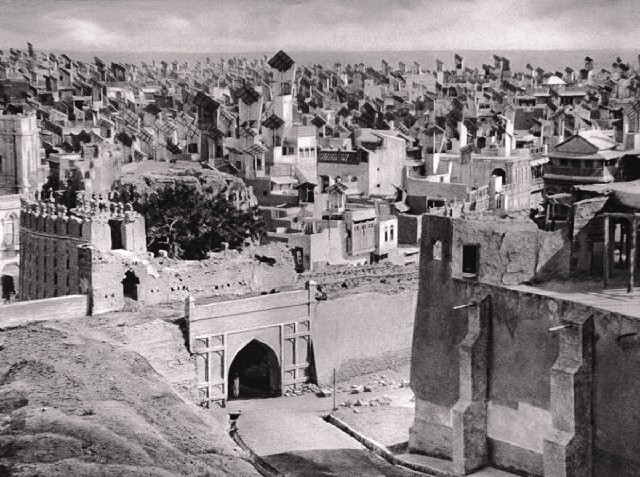 Mangh is the popular name for the wind catcher in Sindh. However, another name which is frequently used in southern Sindh for the wind catcher is Badgeer. In Persian language, there are various names for these wind catchers, such as Batghan Badhanj, Khishkhan, Khishkhod and Vateghz. It is quite interesting that along with travel literature, Persian poetry also made reference to the symbolism of the wind catcher. One of its earlier poems states that: “My heart is happy for the familiar wounds / my house has the air because of the wind catcher” Another poet says that: “As soon as we put my heart in the fire of the house/the wind catcher fights against my fire.”
Mangh is the popular name for the wind catcher in Sindh. However, another name which is frequently used in southern Sindh for the wind catcher is Badgeer. In Persian language, there are various names for these wind catchers, such as Batghan Badhanj, Khishkhan, Khishkhod and Vateghz. It is quite interesting that along with travel literature, Persian poetry also made reference to the symbolism of the wind catcher. One of its earlier poems states that: “My heart is happy for the familiar wounds / my house has the air because of the wind catcher” Another poet says that: “As soon as we put my heart in the fire of the house/the wind catcher fights against my fire.”
Until the previous decade, architectural historians had different opinions about the origin of wind catchers. Some of them thought that wind catchers originated in Egypt, and others argued that this technique was developed in Iran. Lately, when some paintings dated around 1300 BC were discovered, it was found that Ancient Egyptian official Nebamun’s residence had two triangular structures atop. Afterwards, it was resolved that the first wind catcher was developed in Egypt. However, till now archaeological studies in Sindh haven’t focused on minute details of the explored sites. Therefore, we are not sure about the original development of Manghs in Sindh. European and other travel writers have mentioned Manghs in Thatta and Hyderabad. There are books on the traditional architecture of various cities of Sindh (for example, by Yasmeen Lari, Kaleemullah Lashari and Anila Naeem) which have acquired the status of reference works in the area of Sindh’s traditional architecture. Specifically Hyderabad’s traditional architecture, however, awaits comprehensive documentation. Some artists have attempted to fill this gap. According to veteran broadcaster, writer and old inhabitant of Hyderabad Mr. Nasir Mirza, one such artist was Ain Kaf Shaikh (Abdullah Qadir Baksh Shaikh), then Drawing Teacher at the Elementary College, Hyderabad, who made his identity in drawing Manghs.
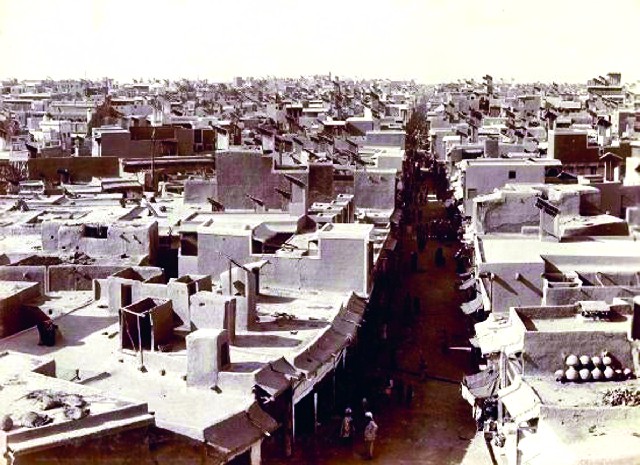 Old photos of the Hirabad area in Hyderabad show that most of the houses had Manghs. The Mangh technology was popular in areas exposed to sea breeze
Old photos of the Hirabad area in Hyderabad show that most of the houses had Manghs. The Mangh technology was popular in areas exposed to sea breeze
Architects interested in local designs and techniques are of the view that the design and use of wind catchers is dependent on factors such as physical geography of the location, wind direction, regularity of air currents, etc. In addition to that, some other factors include the type of settlement, and the possibility of availing other passive cooling mechanisms such as outside windows and ventilators. If these are the principles, then these are very relevant to Hyderabad. The city was located at the sleeping ridge of Ganjo Takar (Bare Mountain), and its boundaries were limited by the Phuleli canal, the Indus River, the forest and swamps. Therefore, the population was concentrated in the old town – around Pakka Qilla, Shahi Bazaar and Fqir Jo Pirr. Consequently, its lanes became narrow, and there were fewer chances to have windows opening on to the streets. Therefore, fresh air was scooped though the Manghs. Old photos of the Hirabad area in Hyderabad show that most of the houses had Manghs. The Mangh technology was popular in areas exposed to sea breeze. Therefore, it reached Matiari, Halla, Sujawal, Thatta, Kotri and Tando Muhmmand Khan. A famous architect and town planner Arif Hasan told this scribe that Manghs existed in all small and large towns of Sindh’s costal belt. He mentioned that Manghs were found in Gjaro, Jati, Gujo, Bathoro and other coastal towns. He added that before the arrival of the British colonialists, Karachi also had Manghs on rooftops – erected in such a way as to catch the sea breeze.
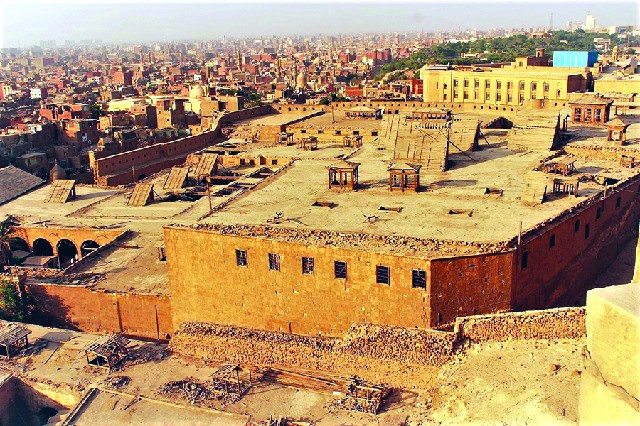
Historians have found different types of wind catchers around the globe, and the most common types are circular, rectangular and square. Interestingly, Hyderabad’s Manghs had a triangular structure. Such a Mangh resembled a chimney having an upward directed lip. Professor, writer and old resident of Hyderabad Dr. Qazi Khadim told this scribe that the Manghs in Hyderabad served the Wado Sufo (central room/hall -type room) of the homes. He elaborated that these Manghs were covered using shutters. And he went on to say that sometimes one Mangh was erected on corner walls of two rooms to serve them simultaneously. But, generally old homes had a separate Mangah for each room. According to him, a Mangh’s opening and closing times in summer and winter were different. In summer, shutters was opened before sunset and closed the next morning, roughly around 11:00 am. This time gave dwellers an opportunity to avail the cool breeze of the south-west. And in winter, the Manghs were opened around 11 am and closed after lunch, at approximately 2:30 pm. Such winter timings enabled them to get warm daylight and moderate wind. Mangh shutters were attached with levers, and operated through a rope. A pull in one direction opened it, and one in the opposite direction closed it.

As mentioned above, Manghs, like other wind catchers, operate in a very particular environment – that is, taking into consideration the availability of wind, its specific direction and sunlight.
A Mangh’s opening and closing times in summer and winter were different
A Mangh takes advantage of the motion of air; its vertical channel acts as a passage for air and a regular air current pushes fresh air into the room. Professor Muhammad Hashim Jokhio, a famous architecture of Hyderabad, told this scribe that Manghs were constructed with a permanent material, and had a unidirectional erection. Therefore, Manghs have a distinguished place in traditional wind catcher architecture. Some of the documents state that this simple technology existed in Hyderabad since 500 years ago, but gradually it became outdated when the British authorities built a power station in the city in the 1920s. The Mangh, being a local architectural technique, was not given due importance in academic works since then, nor has it been substantially considered in town planning. There may be some reasons. Perhaps it required far too specific a natural environment to work. Another possibility is that it became relatively obsolete in mass housing projects. Or perhaps, even now, like other disciplines, our architectural ideas are too Eurocentric!
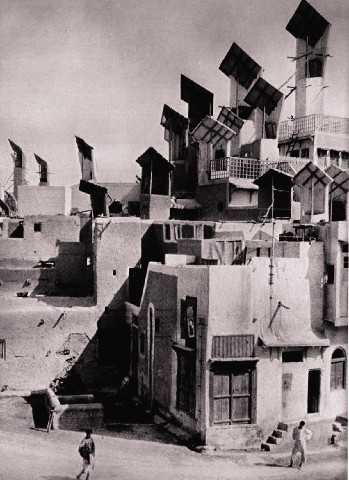 Mangh as a Sindhi architectural technique came under discussion of civil engineers, architects, town planners, interior designers and cost-engineers when in 1964 Bernard Rudofsky published Architecture without Architects: A Short Introduction to Non-pedigreed Architecture. He wrote: “The air-conditioners of Hyderabad Sindh […] these unusual roof-scoops are a prominent feature of lower Sindh. [These] wind-scoops are installed on the roofs, one for each room. Since the wind always blows from the same direction, the positions of the wind-scoops are permanently fixed.” Rudofsky’s book sparked some ideas among young architects, but soon dreams faded out. There may be more than one reason, but I am of the view that mass housing project stakeholders consider Manghs as a part of cultural heritage, rather than a useful technique that could be implemented in new housing projects. Although there are a lot of green tendencies active around the housing industry, none of them have included this simple, cost-effective technique in their finance-intensive projects.
Mangh as a Sindhi architectural technique came under discussion of civil engineers, architects, town planners, interior designers and cost-engineers when in 1964 Bernard Rudofsky published Architecture without Architects: A Short Introduction to Non-pedigreed Architecture. He wrote: “The air-conditioners of Hyderabad Sindh […] these unusual roof-scoops are a prominent feature of lower Sindh. [These] wind-scoops are installed on the roofs, one for each room. Since the wind always blows from the same direction, the positions of the wind-scoops are permanently fixed.” Rudofsky’s book sparked some ideas among young architects, but soon dreams faded out. There may be more than one reason, but I am of the view that mass housing project stakeholders consider Manghs as a part of cultural heritage, rather than a useful technique that could be implemented in new housing projects. Although there are a lot of green tendencies active around the housing industry, none of them have included this simple, cost-effective technique in their finance-intensive projects.
Presently, some town planners are including vernacular techniques in buildings. However, these traditional techniques are applied to add aesthetic aspects or symbolize the local identity. Functionality is not the main consideration. And so, the true challenge before the housing industry is about the usage of local architectural techniques not merely as aesthetic symbols but as useful parts of buildings.
___________________
 Dr. Zaffar Junejo has a Ph.D. in History from the University of Malaya. His areas of interest are post-colonial history, social history and peasants’ history.
Dr. Zaffar Junejo has a Ph.D. in History from the University of Malaya. His areas of interest are post-colonial history, social history and peasants’ history.
Courtesy: The Friday Times, Naya Daur, Lahore (Published on July 24, 2021)